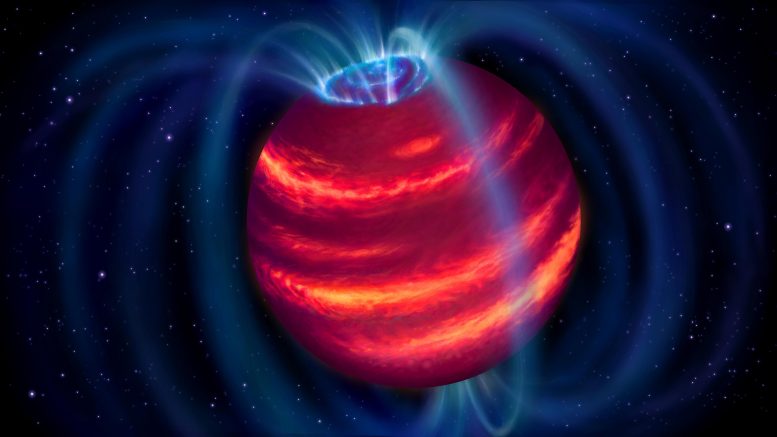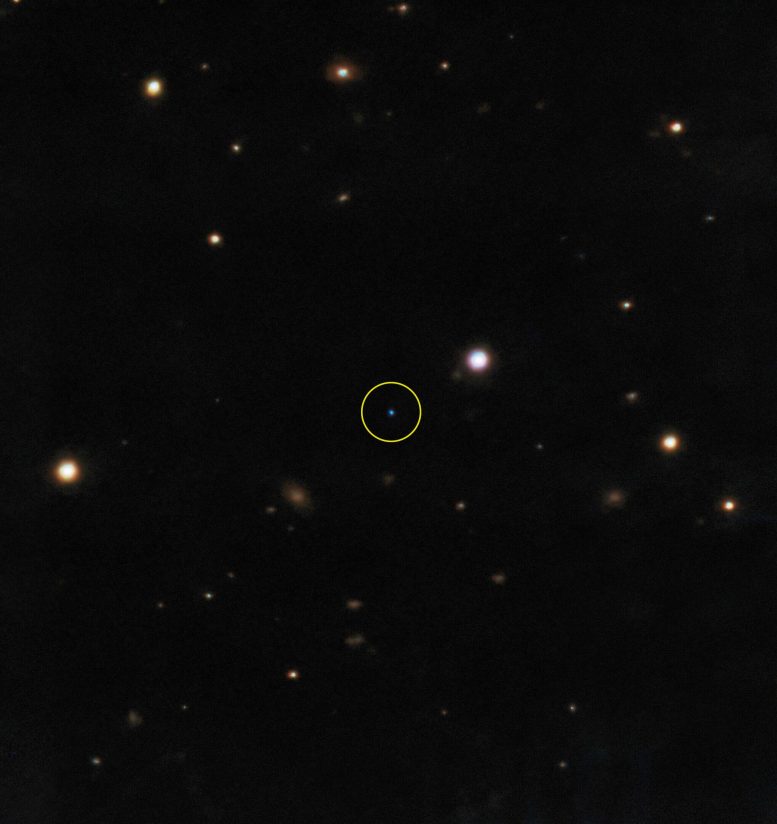
Posted on 11/13/2020 8:57:23 AM PST by Red Badger

Artist’s impression of the cold brown dwarf BDR J1750+3809. The blue loops depict the magnetic field lines. Charged particles moving along these lines emit radio waves that LOFAR detected. Some particles eventually reach the poles and generate aurorae similar to the northern lights on Earth. Credit: ASTRON/Danielle Futselaar
==========================================================================
Gemini North and IRTF Confirm LOFAR Discovery
For the first time, astronomers have used observations from the LOFAR radio telescope, the NASA IRTF, operated by the University of Hawai‘i, and the international Gemini Observatory, a Program of NSF’s NOIRLab, to discover and characterize a cold brown dwarf. The object, designated BDR J1750+3809, is the first substellar object to be discovered through radio observations — until now, brown dwarfs have been uncovered in large infrared and optical surveys. Directly discovering these objects with sensitive radio telescopes such as LOFAR is a significant breakthrough because it demonstrates that astronomers can detect objects that are too cold and faint to be found in existing infrared surveys — maybe even large free-floating exoplanets.
“In this discovery, Gemini was particularly important because it identified the object as a brown dwarf and also gave us an indication of the temperature of the object,” explained lead author Harish Vedantham of ASTRON, the Netherlands Institute for Radio Astronomy. “The Gemini observations told us that the object was cold enough for methane to form in its atmosphere — showing us that the object is a close cousin of Solar System planets like Jupiter.”
VIDEO AT LINK...................
Brown dwarfs are substellar objects straddling the boundary between the largest planets and the smallest stars.[1] Occasionally dubbed failed stars, brown dwarfs lack the mass to trigger hydrogen fusion in their cores, instead glowing at infrared wavelengths with leftover heat from their formation. While they lack the fusion reactions that keep our Sun shining, brown dwarfs can emit light at radio wavelengths. The underlying process powering this radio emission is familiar, as it occurs in the largest planet in the Solar System. Jupiter’s powerful magnetic field accelerates charged particles such as electrons, which in turn produces radiation — in this case, radio waves[3] and aurorae.
The fact that brown dwarfs are radio emitters allowed the international collaboration of astronomers behind this result to develop a novel observing strategy. Radio emissions have previously been detected from only a handful of cold brown dwarfs — and they have been known and cataloged by infrared surveys before being observed with radio telescopes. The team decided to flip this strategy, using a sensitive radio telescope to discover cold, faint sources and then perform follow-up infrared observations with a large telescope like the 8-meter Gemini North telescope to categorize them.

An infrared image of the cold brown dwarf BDR J1750+3809 taken with Gemini North’s acquisition camera for the Gemini Near-Infrared Spectrograph (GNIRS) and Gemini’s Near InfraRed Imager and spectrograph (NIRI). The image is a color composite showing the infrared filters in chromatic order, which is why the brown dwarf appears blue. The image is a color composite showing the infrared filters in chromatic order, which is why the brown dwarf appears blue. Credit: International Gemini Observatory/NOIRLab/NSF/AURA/H. Vedantham/UKIRT Hemisphere Survey
==========================================================================
“We asked ourselves, ‘Why point our radio telescope at cataloged brown dwarfs?’,” said Vedantham. “Let’s just make a large image of the sky and discover these objects directly in the radio.”
Having found a variety of tell-tale radio signatures in their observations, the team had to distinguish potentially interesting sources from background galaxies. To do so, they searched for a special form of light that was circularly polarized[3] — a feature of light from stars, planets, and brown dwarfs, but not from background galaxies. Having found a circularly polarized radio source, the team then turned to telescopes including Gemini North and the NASA IRTF to provide the measurements required to identify their discovery.
VIDEO AT LINK......................
This video zooms into BDR J1750+3809, a cold brown dwarf. A collaboration between the LOw Frequency ARray (LOFAR) radio telescope in Europe, the Gemini North telescope, and the NASA InfraRed Telescope Facility (IRTF), both on Maunakea in Hawai‘i, has led to the first direct discovery of a cold brown dwarf from its radio wavelength emission.Credit: International Gemini Observatory/NOIRLab/NSF/AURA/Lomberg J, S. Brunier/Digitized Sky Survey 2.
==========================================================================
Gemini North is equipped with a variety of infrared instruments, one of which is usually kept ready to observe when an interesting astronomical opportunity arises. In the case of BDR J1750+3809, Gemini’s mainstay infrared imager, the Near InfraRed Imager and spectrograph (NIRI), was not available — so Gemini astronomers took the unusual step of using the acquisition camera for the Gemini Near-Infrared Spectrograph (GNIRS) instead. Thanks to the careful work and foresight of Gemini staff, this camera provided deep, sharp, and accurate imaging at several infrared wavelengths.
“These observations really highlight the versatility of Gemini, and in particular the little-used ‘keyhole’ imaging capability of Gemini’s GNIRS spectrograph,” commented Gemini Observatory and University of Edinburgh astronomer Trent Dupuy — a co-author of the research paper. The Gemini North observations were obtained via Director’s Discretionary Time, which is reserved for programs needing small amounts of observing time with potentially high-impact results.

This long-duration fish-eye view of the Gemini North telescope facility shows the propagation of the laser guide star (LGS) laser on the night of May 21, 2010. Featuring the sky over Mauna Kea (looking north), the glow of both dusk and dawn, as well as star trails, fill the sky and provide a backdrop for the orange glow of the Gemini LGS laser as it tracks through the sky. The LGS laser from the W.M. Keck Observatory and the peak of Haleakalā on Maui can be seen on close examination of the image. The bright streak on the left is the setting moon. From left to right, the observatories are; Subaru, Keck (twin domes), NASA IRTF, and CFHT (just behind Gemini). The images used to create this picture were captured as part of a time-lapse movie and then stacked in Photoshop. Credit: International Gemini Observatory/Joy Pollard
==========================================================================
“This observation showcases both the flexibility and the power of the Gemini Observatories,” said Martin Still of the National Science Foundation (NSF). “This was an opportunity where Gemini’s design and operations enabled an innovative idea to develop into a significant discovery.”
As well as being an exciting result in its own right, the discovery of BDR J1750+3809 could provide a tantalizing glimpse into a future when astronomers can measure the properties of exoplanets’ magnetic fields. Cold brown dwarfs are the closest things to exoplanets that astronomers can currently detect with radio telescopes, and this discovery could be used to test theories predicting the magnetic field strength of exoplanets. Magnetic fields are an important factor in determining atmospheric properties and long term evolution of exoplanets.
“Our ultimate goal is to understand magnetism in exoplanets and how it impacts their ability to host life,” concluded Vedantham. “Because magnetic phenomena of cold brown dwarfs are so similar to what is seen in Solar System planets, we expect our work to provide vital data to test theoretical models that predict the magnetic fields of exoplanets.” Notes
The first unambiguous observation of a brown dwarf did not occur until 1995, after more than 30 years of theoretical predictions. The name of these objects was coined by the American astronomer Jill Tarter in reference to their expected color. The radiation emitted by the acceleration of charged particles in a magnetic field is referred to as cyclotron radiation. The name comes from the cyclotron, an early type of particle accelerator. Circularly polarized light is also used to create 3D movies.
More information
This research was presented in the paper Direct Radio Discovery of a Cold Brown Dwarf to appear in The Astrophysical Journal Letters.
The team is composed of H. K. Vedantham (ASTRON and University of Groningen), J. R. Callingham (Leiden Observatory and ASTRON), T. W. Shimwell (ASTRON and Leiden Observatory), T. Dupuy (University of Edinburgh and Gemini Observatory/NSF’s NOIRLab), William M. J. Best (University of Texas and Visiting Astronomer at the NASA IRTF, Michael C. Liu (University of Hawai‘i and Visiting Astronomer at the NASA IRTF), Zhoujian Zhang (University of Hawai‘i), K. De (California Institute of Technology), L. Lamy (LESIA, Observatoire de Paris), P. Zarka (LESIA, Observatoire de Paris), H. J. A. Röttgering (Leiden Observatory), and A. Shulevski (Leiden Observatory).
NSF’s NOIRLab (National Optical-Infrared Astronomy Research Laboratory), the US center for ground-based optical-infrared astronomy, operates the international Gemini Observatory (a facility of NSF, NRC–Canada, ANID–Chile, MCTIC–Brazil, MINCyT–Argentina, and KASI–Republic of Korea), Kitt Peak National Observatory (KPNO), Cerro Tololo Inter-American Observatory (CTIO), the Community Science and Data Center (CSDC), and Vera C. Rubin Observatory. It is managed by the Association of Universities for Research in Astronomy (AURA) under a cooperative agreement with NSF and is headquartered in Tucson, Arizona. The astronomical community is honored to have the opportunity to conduct astronomical research on Iolkam Du’ag (Kitt Peak) in Arizona, on Maunakea in Hawai?i, and on Cerro Tololo and Cerro Pachón in Chile. We recognize and acknowledge the very significant cultural role and reverence that these sites have to the Tohono O’odham Nation, to the Native Hawaiian community, and to the local communities in Chile, respectively.

Ping!.............

My apologies. A little bit of, perhaps, ill placed humour on my part. I've been OD'ing on way too much info on how True-dope has screwed Canada through his illegal actions and the Demonrat's coup attempt in the US.
In the backwards time universe the Cat found a brown dwarf too.

That is certainly the intersection of racism and ableism. Is that the best you got? I bet that I could get more “ism” intersections if I really tried!
There will be little humor here...
Astronomers are SO far behind. That is a “Dwarf of Color.”
Isn’t the headline racist and discriminatory?

Imagine starships having to turn on their lights to see the brown dwarfs and weave around them.... zig... zag... zig
Thanks Red Badger.

Disclaimer: Opinions posted on Free Republic are those of the individual posters and do not necessarily represent the opinion of Free Republic or its management. All materials posted herein are protected by copyright law and the exemption for fair use of copyrighted works.